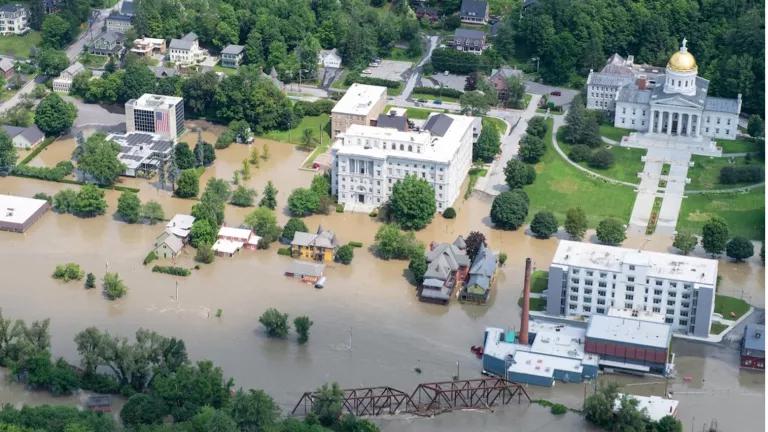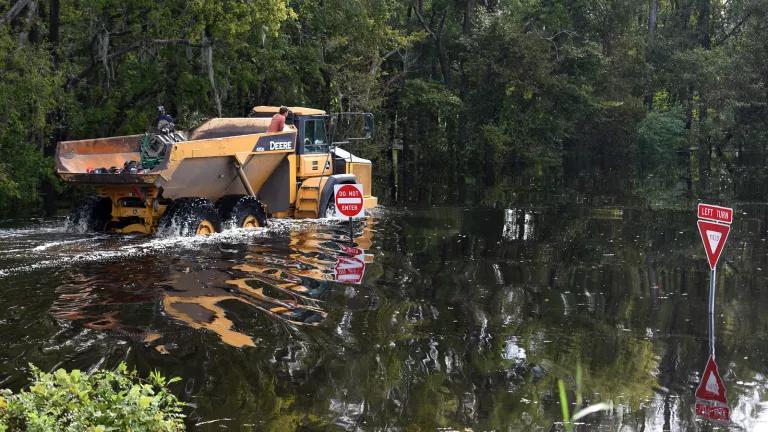Flood Protection Standard Is Key Climate Adaptation Tool
The flood-related impacts of climate change are happening now. We cannot afford to wait.

A Vermont National Guard helicopter surveys flood damage in the state's capital, Montpelier, Vt., July 11, 2023.
Soon after taking office in 2021, President Biden issued an executive order that reinstated the Federal Flood Risk Management Standard. Revoked by former President Trump 10 days before Hurricane Harvey, this standard requires all federally funded infrastructure, like public housing, hospitals, fire stations, and highways, to be constructed and located to withstand future flood risks. It will help reduce the loss of these services during major flood events—protecting lives, lowering disaster costs, and saving taxpayer dollars.
Federal agencies have begun to implement this flood protection standard into their infrastructure funding programs. The Federal Emergency Management Agency (“FEMA”) recently closed a public comment period on its proposed regulations for implementing this standard. NRDC filed comments in support of the proposed rules. This past summer, the Department of Housing and Urban Development (“HUD”) similarly moved to update its regulations for implementing the standard. FEMA and HUD are important agencies, given their roles in post-disaster recovery and rebuilding – and HUD’s role in community development and housing.
However, more agencies – particularly those who distribute tens of billions of dollars in transportation, energy, and water infrastructure – need to follow FEMA’s and HUD’s example. Doing so will ensure that any project that receives funding from a federal agency is built with full consideration of future flood risks and rising seas, as required by President Biden’s executive order.
The effects of climate change necessitate a higher resilience standard for flooding.
The flood-related impacts of climate change are happening now. We cannot afford to wait.
More extreme rainfall and rising seas, the impacts of climate change, are exacerbating flood risk across the nation. As such, homes, schools, and critical infrastructure are increasingly damaged by flooding, which not only costs the American taxpayer, but disrupts the lives and livelihoods of everyone who relies on such infrastructure. Per the recently released Fifth National Climate Assessment – the federal government’s definitive climate change report– climate change is and will continue to increase the frequency of water-related disasters across the nation.

Source: The Fifth National Climate Assessment.
The flood standard was developed because it is no longer safe or adequate to build for the flood risks of the past. It directs federal agencies to use more protective siting and design requirements for infrastructure projects that receive federal funding, such as affordable housing, emergency response facilities, and water and wastewater systems. Projects are required to be located outside of low-lying areas vulnerable to flooding whenever practicable. When not practicable, they are required to be more resilient against future flood conditions, including the impacts of sea-level rise.
More federal agencies need to act.
Last spring, HUD issued a proposed rule detailing the agency’s plans to ensure affordable housing is safer from a future flooding. The proposal requires, among many changes, higher elevation requirements for new or improved HUD-financed infrastructure if located in a floodplain.
Likewise, FEMA is seeking to update its requirements for locating and building in a floodplain. FEMA has proposed all construction projects funded by the agency account for the climate-related flood impacts, like sea-level rise, over the lifetime of the project. FEMA has also proposed that any project located in a floodplain or wetland must use natural features and nature-based approaches to preserve the beneficial functions of floodplains and wetlands.
Given the billions FEMA spends on rebuilding and mitigating flood-prone infrastructure, these new standards are sorely needed. Since the 1990s, FEMA has spent more than $103.5 billion (adjusted for inflation in 2022 dollars) repairing public infrastructure damaged by floods and flood-related events, like hurricanes and severe storms. Similarly, FEMA has spent nearly $18 billion (adjusted for inflation in 2022 dollars) on reducing long term flood risk to protect people and property from flood-related hazards. If finalized, FEMA’s proposed regulations will help to reduce those disaster costs by ensuring homes and public infrastructure meet a higher standard of flood protection.
Other agencies, like the Army Corps of Engineers and the Environmental Protection Agency, are updating their procedures to account for the reinstated FFRMS. However, too many other federal agencies are dragging their feet on implementing the standard. Agencies, like the departments of Transportation and Energy – both big funders of infrastructure – must act now.
Federal agencies are now investing hundreds of billions of dollars from the Infrastructure Investment and Jobs Act and the Inflation Reduction Act to construct major public works. For example, DOT received nearly $150 billion just for the National Highway Performance Program, which provides for the construction of new facilities. It’s important that these projects be built with future flood risks and rising seas in mind. Failure to do so means a lot of these investments will be damaged or destroyed by disasters that should have been anticipated.
Heavier rains, intensifying coastal storms, and rising seas—the impacts of climate change—are exacerbating the risk of flooding across the United States. Communities already struggle to maintain aged and deteriorating infrastructure. New infrastructure built absent climate consideration only sets these communities up for the same issues. All federal agencies that fund infrastructure must account for increasing flood risk by swiftly implementing the federal flood standard.




